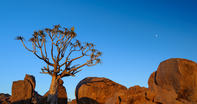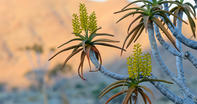Kokerbooms
The Aloe Trees are another staple of the Richtersveld landscape. Also called kokerbooms, or quiver trees, these attractive stem succulents can live up to 400 years and they come in a variety of shapes and sizes. They are fairly common and can be seen sticking out of rocky ridges and, occasionally, along the roadside.

The name ‘quiver tree’ refers to the Bushman and Khoikhoi hunters, who used to carry their arrows in hollowed-out kokerboom branches. In the Richtersveld, 3 of the 5 species of kokerboom can be found.
These are: The plain old Quiver Tree/Kokerboom (Aloe dichotoma). It grows up to 9m high and is characterised by a large central stem with a broad spray of branches and leaves growing out of the upper reaches. It’s found east of the Stinkfontein mountains and in the arid northern Richtersveld, where it tends to grow taller with simpler branch structures.
The kokerboom forest (more correctly called a colony) in the Richtersveld National Park is the best place to check out these ancient aloes. Pillan’s Quiver Tree, also called the Bastard Quiver Tree or Basterkokerboom (A. pillansii). It grows up to 10m tall with a thick stem. It has fewer, thicker branches and larger leaves than its cousin, A. dichotoma.
They grow on mountain slopes close to the Orange River, from Baken to the Tatasberg, with a southern extension on the Dragon’s Back mountain near Eksteenfontein. In the Richtersveld National Park, they can be seen in Helskloof and on Cornell’s Kop.
The Maiden’s Quiver Tree, or Nooienskokerboom (A. ramosissima): Less common than the other kokerbooms, this aloe resembles a shrub rather than a tree. It has many branches that spread out from low down on the central structure. It can grow up to several metres high and blooms with bright yellow flowers, usually in May. Found in the higher mountain slopes and occasionally in riverbeds.
A Rare Shrub

A rather rare shrub, the Pearson’s Aloe (Aloe pearsonii) is endemic to Helskloof in the Richtersveld National Park and adjacent mountains across the Orange River in Namibia. It has many low branches with triangular leaves that grow in dense layers, with four leaves per layer. These layers curve downwards in an attractive geometric pattern.
The colony at Helskloof is extensive and the plants literally cover the mountains of either side of the rocky road pass. The plant is named after Dr. H.H.W. Pearson, the first director of Kirstenbosch Botanical Gardens, who first collected the plant in 1910.
By David Fleminger